
Types of Attacks
- Structured attack
Come from hackers who are more highly motivated and technically competent. These people know system vulnerabilities and can understand and develop exploit code and scripts. They understand, develop, and use sophisticated hacking techniques to penetrate unsuspecting businesses. These groups are often involved with the major fraud and theft cases reported to law enforcement agencies.
- Unstructured attack
Consists of mostly inexperienced individuals using easily available hacking tools such as shell scripts and password crackers. Even unstructured threats that are only executed with the intent of testing and challenging a hacker’s skills can still do serious damage to a company.
- External attacks
Initiated by individuals or groups working outside of a company. They do not have authorized access to the computer systems or network. They gather information in order to work their way into a network mainly from the Internet or dialup access servers.
- Internal attacks
More common and dangerous. Internal attacks are initiated by someone who has authorized access to the network. According to the FBI, internal access and misuse account for 60 to 80 percent of reported incidents. These attacks often are traced to disgruntled employees.
- Passive Attack
-Listen to system passwords
-Release of message content
-Traffic analysis
-Data capturing
- Active Attack
-Attempt to log into someone else’s account
-Wire taps
-Denial of services
-Masquerading
-Message modifications
Specific Network Attacks 

- ARP Attack
- Brute Force Attack
- Worms
- Flooding
- Sniffers
- Spoofing
- Redirected Attacks
- Tunneling Attack
- Covert Channels
Denial-of-Service Facts
• Commonly used against information stores like web sites .
• Simple and usually quite effective .
• Does not pose a direct threat to sensitive data .
• The attacker tries to prevent a service from being used and making that service unavailable to legitimate users .
• Attackers typically go for high visibility targets such as the web server, or for infrastructure targets like routers and network links .
Denial-of-Service Example :
If a mail server is capable of receiving and delivering 10 messages a second, an attacker simply sends 20 messages per second. The legitimate traffic (as well as a lot of the malicious traffic) will get dropped, or the mail server might stop responding entirely.
- This type of an attack may be used as a diversion while another attack is made to actually compromise systems
- In addition, administrators are likely to make mistakes during an attack and possibly change a setting that creates a vulnerability that can be further exploited
Types of Denial-of-Service Attacks
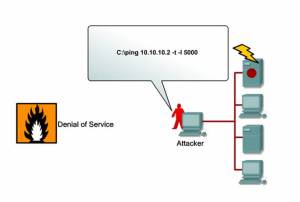
SYN Flood Attack
Teardrop Attacks
Smurf Attack
DNS Attacks
Email Attacks
Physical Infrastructure Attacks
Viruses/Worms
- DoS – Buffer Overflow Attacks

The most common DoS attack sends more traffic to a device than the program anticipates that someone might send Buffer Overflow.
- DoS – SYN Flood Attack • When connection sessions are initiated between a client and server in a network, a very small space exists to handle the usually rapid “hand-shaking” exchange of messages that sets up a session.• The session-establishing packets include a SYN field that identifies the sequence order.• To cause this kind of attack, an attacker can send many packets, usually from a spoofed address, thus ensuring that no response is sent.
- DoS – Teardrop Attack
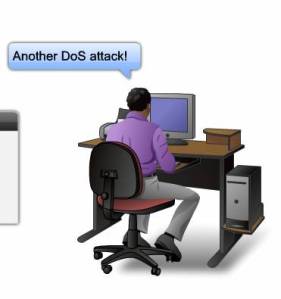
- Exploits the way that the Internet Protocol (IP) requires a packet that is too large for the next router to handle be divided into fragments.• The fragmented packet identifies an offset to the beginning of the first packet that enables the entire packet to be reassembled by the receiving system.• In the teardrop attack, an attacker’s IP puts a confusing value in the second or later fragment. If the receiving operating system cannot cope with such fragmentation, then it can cause the system to crash.
- DoS – Smurf Attack
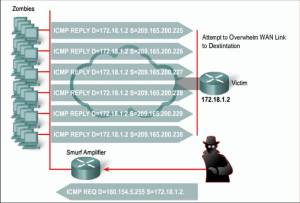
- The attacker sends an IP ping
request to a network site.The ping packet requests that it
be broadcast to a number of hosts
within that local network.The packet also indicates that the
request is from a different site, i.e.
the victim site that is to receive the
denial of service.This is called IP Spoofing–the victim site becomes the address of the originating packet.The result is that lots of ping replies flood back to the victim host. If the flood is big enough then the victim host will no longer be able to receive or process “real” traffic.
- DoS – DNS Attacks
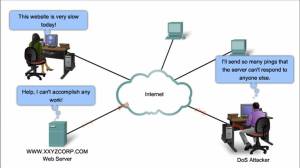 • A famous DNS attack was
• A famous DNS attack was
a DDoS “ping” attack. The
attackers broke into
machines on the Internet
(popularly called “zombies”)
and sent streams of forged
packets at the 13 DNS
root servers via intermediary
legitimate machines.• The goal was to clog the servers, and communication links on the way to the servers, so that useful traffic was gridlocked. The assault is not DNS-specific–the same attack has been used against several popular Web servers in the last few years.
- DoS – Email Attacks
 • When using Microsoft Outlook, a script reads your address book and sends a copy of itself to everyone listed there, thus propagating itself around the Internet.• The script then modifies the computer’s registry so that the script runs itself again when restarted.
• When using Microsoft Outlook, a script reads your address book and sends a copy of itself to everyone listed there, thus propagating itself around the Internet.• The script then modifies the computer’s registry so that the script runs itself again when restarted.
- DoS – Physical Infrastructure Attacks • Someone can just simply snip your cables! Fortunately this can be quickly noticed and dealt with.• Other physical infrastructure attacks can include recycling systems, affecting power to systems and actual destruction of computers or storage devices.
- DoS – Viruses/Worms
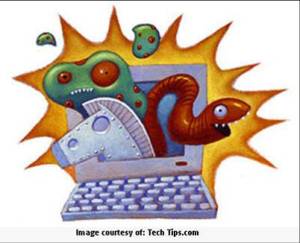 • Viruses or worms, which replicate across a network in various ways, can be viewed as denial-of-service attacks where the victim is not usually specifically targeted but simply a host unlucky enough to get the virus.• Available bandwidth can become saturated as the virus/worm attempts to replicate itself and find new victims.
• Viruses or worms, which replicate across a network in various ways, can be viewed as denial-of-service attacks where the victim is not usually specifically targeted but simply a host unlucky enough to get the virus.• Available bandwidth can become saturated as the virus/worm attempts to replicate itself and find new victims.
- Malicious Code Attacks
 • Malicious code attacks refers to viruses, worms, Trojan horses, logic bombs, and other uninvited software• Damages personal computers, but also attacks systems that are more sophisticated• Actual costs attributed to the presence of malicious code have resulted primarily from system outages and staff time involved in repairing the systems• Costs can be significant
• Malicious code attacks refers to viruses, worms, Trojan horses, logic bombs, and other uninvited software• Damages personal computers, but also attacks systems that are more sophisticated• Actual costs attributed to the presence of malicious code have resulted primarily from system outages and staff time involved in repairing the systems• Costs can be significant
- Packet Sniffing Attacks
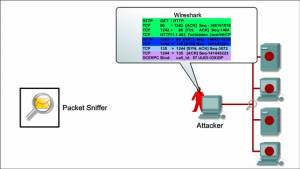 • Most organization LANs are Ethernet networks• On Ethernet-based networks, any machine on the network can see the traffic for every machine on that network• Sniffer programs exploit this characteristic, monitoring all traffic and capturing the first 128 bytes or so of every unencrypted FTP or Telnet session (the part that contains user passwords) .
• Most organization LANs are Ethernet networks• On Ethernet-based networks, any machine on the network can see the traffic for every machine on that network• Sniffer programs exploit this characteristic, monitoring all traffic and capturing the first 128 bytes or so of every unencrypted FTP or Telnet session (the part that contains user passwords) .
- Information Leakage Attacks • Attackers can sometimes get data without having to directly use computers• Exploit Internet services that are intended to give out information• Induce these services to reveal extra information or to give it out to unauthorized people• Many services designed for use on local area networks do not have the security needed for safe use across the Internet• Thus these services become the means for important information leakage
- Social Engineering Attacks • Hacker-speak for tricking a person into revealing some confidential information• Social Engineering is defined as an attack based on deceiving users or administrators at the target site• Done to gain illicit access to systems or useful information• The goals of social engineering are fraud, network intrusion, industrial espionage, identity theft, etc.
Attack Methodology
- Stages – the methodology of network attacks is well documented and researched. This research has led to greater understanding of network attacks and an entire specialization of engineers that test and protect networks against attacks (Certified Ethical Hackers/Penetration Testers)
- Tools – penetration testers have a variety of power tools that are now commercially available. They also have may open source free tools. This proliferation of powerful tools has increased the threat of attack due to the fact that even technical novices can now launch sophisticated attacks.
Stages of an Attack
• Today’s attackers have a abundance of targets. In fact their greatest challenge is to select the most vulnerable victims. This has resulted in very well- planned and structured attacks. These attacks have common logistical and strategic stages. These stages include;
-Reconnaissance
-Scanning (addresses, ports, vulnerabilities)
-Gaining access
-Maintaining Access
-Covering Tracks
Tools of the Attacker
• The following are a few of the most popular tools used by network attackers:
-Enumeration tools (dumpreg, netview and netuser)
-Port/address scanners (AngryIP, nmap, Nessus)
-Vulnerability scanners (Meta Sploit, Core Impact, ISS)
-Packet Sniffers (Snort, Wire Shark, Air Magnet)
-Cryptographic cracking tools (Cain, WepCrack)
-Malicious codes (worms, Trojan horse, time bombs)
-System hijack tools (netcat, MetaSploit, Core Impact)

No comments:
Post a Comment